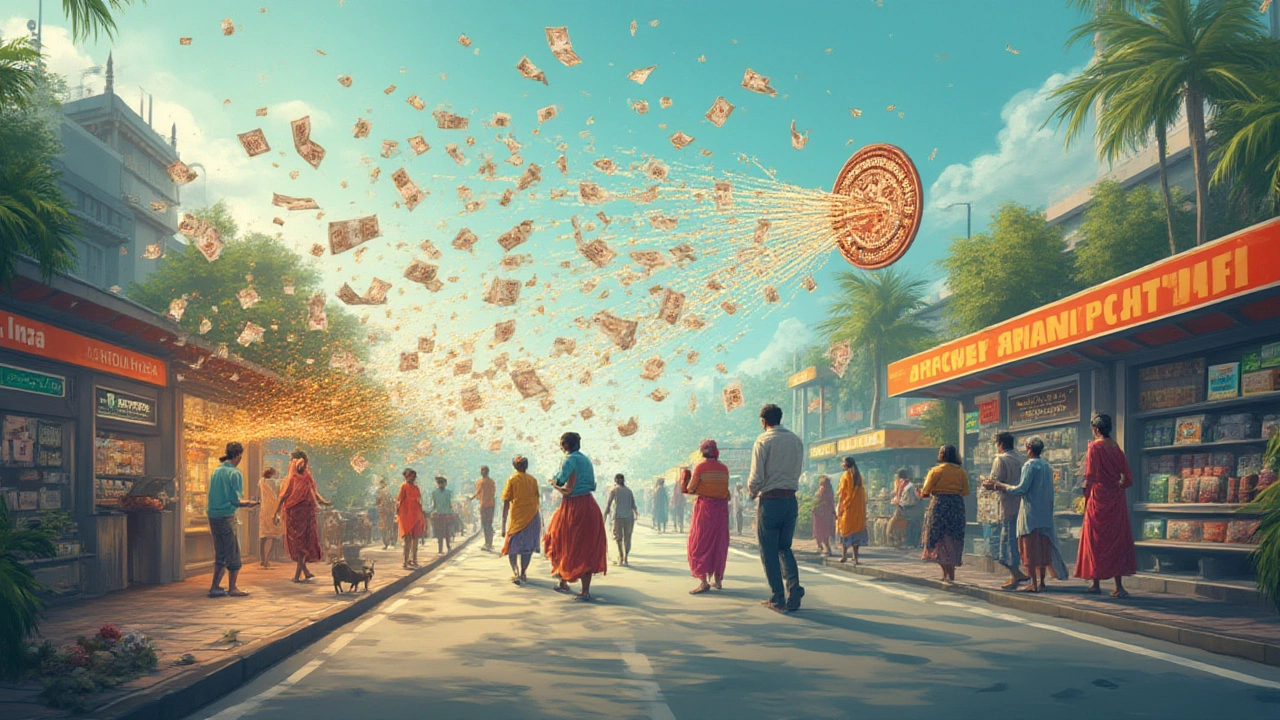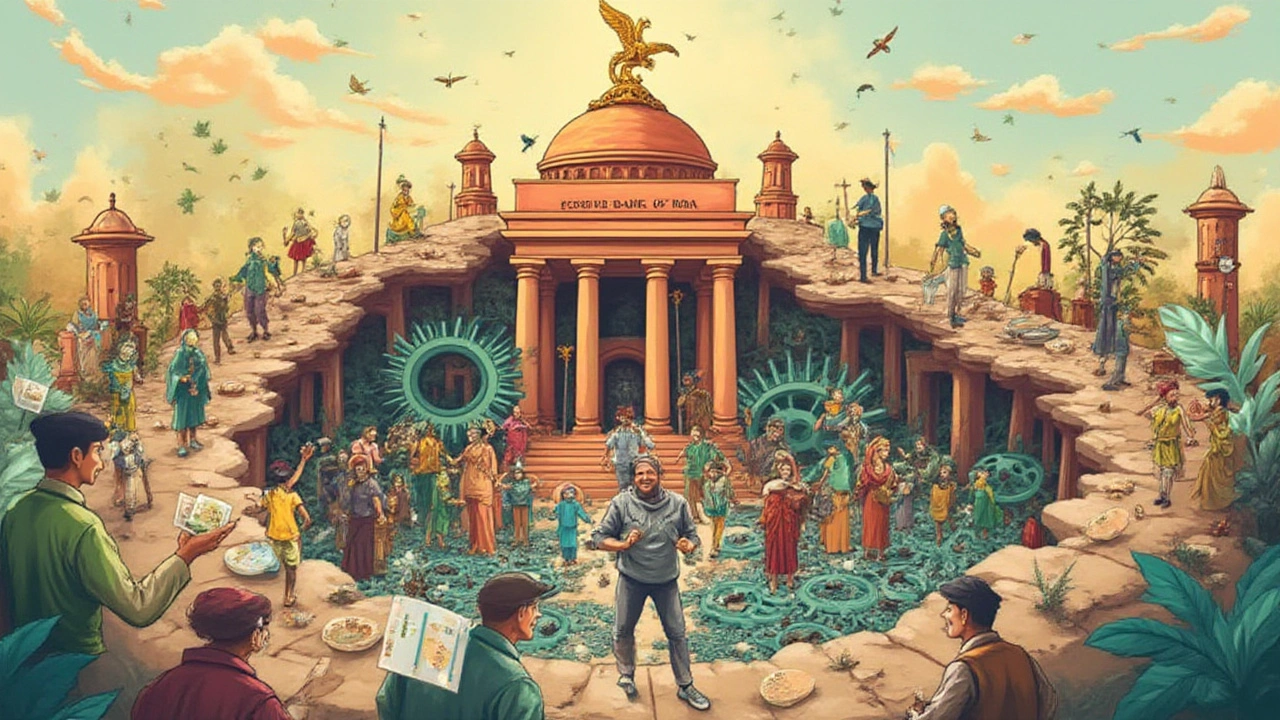Ever wondered who gets to press the button that makes money appear in India? Some people think money just gets printed whenever the government wants, as if there’s a secret room filled with men in suits churning out colourful notes. The reality is a lot less Hollywood, but honestly, even more fascinating — and a bit surprising. The journey from a policymaker’s office to the cash in your hand is full of secretive steps, regulations, and way more math than most expect. No, your local bank can’t simply invent rupees at will, but there are times when digital money almost seems to appear out of thin air. So, who actually creates money in India, and how does that all shape the economy that we live in?
The Real Makers of Money: RBI, Government, and Banks
So here’s the shocker: the Reserve Bank of India (RBI) is the only entity that can legally “create” most of the money you use, and it works in tight coordination with the Government of India. RBI’s job stretches beyond printing those crisp ₹500 notes. On a boring weekday in Nashik, Dewas, Mysuru, or Salboni (these are actual cities where presses are based), bundles of currency notes zip out of massive machines. But, not a single note rolls out without the green light from the top—the government signs off on the broad supply, but only the RBI makes it official. Even coins are handled mostly by the government, minted separately and then distributed by RBI.
It’s not just the physical currency, though. There’s also “broad money,” which is the electronic, digital numbers that you see in your bank app or netbanking statement. RBI controls the core, base money—notes, coins, and reserves that banks can use. But the plot thickens: commercial banks, public and private, create new money in the economy every day—but only in a special way. They do this through lending. Here’s a bit that surprises most: when you take a loan, no bags of rupees move around. The bank simply credits your account, creating a deposit—a new number in the system, not money printed at the press!
That twist is called credit creation. It powers most of the money movement in the economy. According to RBI research, more than 80% of the broad money supply (a number called M3) isn’t hard cash at all within India—it’s digital deposits, thanks to banks giving out loans for homes, cars, or even startups. This means, even though RBI gets to decide how much new base money to put out, commercial banks, in effect, multiply that amount when they lend.
Let’s break that down a bit. Suppose RBI decides to add ₹1,00,000 of fresh money through what’s called an “open market operation”—buying government bonds from banks and paying them cash. This increases the reserves of those banks. Banks, thanks to the “fractional reserve” practice, don’t keep all those reserves locked in the vault. If the current required reserve ratio is 4% (the “Cash Reserve Ratio” or CRR set by RBI now), banks can lend out the other 96%. The person who borrows this money will spend it, and the receiver (let’s say a shopkeeper) deposits it in their bank. That bank can now lend out 96% of those new deposits, and the cycle goes on, amplifying the starting money into far more through the economy.
The data behind all this? As of March 2025, India’s broad money supply (M3) crossed ₹240 lakh crores (about 2.4 quadrillion rupees), but only around 13% of that was in actual notes and coins (currency with the public).
| Type | Amount (March 2025) | Percentage of Total M3 |
|---|---|---|
| Currency (Notes & Coins) | ₹31 Lakh Crore | 13% |
| Bank Deposits | ₹209 Lakh Crore | 87% |
Bottom line: RBI’s invisible hand controls the spigot, but banks mix the punch bowl through lending and deposits. The actual cash you get out at the ATM comes from a much smaller pool than most expect.

How the RBI Controls India’s Money Supply
Okay, so the RBI gets to say how much new money enters circulation and how much banks can multiply through loans. But how does it actually decide these things? It’s not as simple as printing more notes whenever the prime minister wants to spend more. India actually follows a carefully managed system, balancing inflation, economic growth, and the stability of the rupee.
RBI’s main tricks for controlling the money supply will sound a bit dry, but they’re powerful: repo rate, reverse repo rate, CRR (Cash Reserve Ratio), and SLR (Statutory Liquidity Ratio). Think of the repo rate as the interest rate at which commercial banks can borrow money from the RBI. If the RBI wants to slow down lending (usually when inflation’s running hot), they make borrowing more expensive by raising the repo rate. This encourages banks to lend less, which slows down the spread of new money in the system. Lowering the rate does the opposite—a trick RBI sometimes uses when the economy needs a boost, like in the post-pandemic years or after a global slowdown.
Another weapon is the CRR—the percentage of deposits banks must keep frozen as reserves with the RBI. If the RBI hikes the CRR, banks have to lock away more money and can’t lend as freely, which reins in credit creation. The same logic goes for SLR, except banks have to invest in approved assets like government securities.
Open market operations are where RBI buys or sells government securities in the open market. Buying means pumping new cash into the banking system (easing the money supply), while selling securities has the opposite effect—sucking money out of the system. These moves have a ripple effect on everything: home loans, business cash, consumer spending, and even your EMIs.
One recent example: In 2022-23, when inflation ticked above 7%, RBI reacted fast with a series of repo rate hikes, nudging up the rate from 4.0% to 6.5%. You may have noticed your loan EMIs going up—this was the reason. But as inflation cooled in early 2025, RBI started signaling it might soon drop rates, opening the tap for more affordable loans.
There’s another under-the-radar fact: RBI doesn’t just create new money on a whim. Every fresh batch of currency must be balanced by matching “assets” on the RBI balance sheet—like foreign exchange reserves, gold, or government bonds. Each new ₹2,000 note in your wallet has something backing it up somewhere, at least on paper. The RBI’s vaults in Mumbai, for instance, store over 700 tonnes of gold as part of its reserve pile—partly backing all that rupee creation. And, if you’re wondering about coins, the face value of coins isn’t always equal to their cost of production; in fact, many small coins are a net loss per piece, but the continuity matters for daily transactions.
With the rise of digital payments—think UPI, IMPS, online wallets—RBI has kept one step ahead, rolling out the e-Rupee in late 2023. The “digital rupee” is also created and controlled by the RBI, but it exists only in digital wallets assigned by selected banks. It’s new, but as of mid 2025, about ₹5,000 crore worth of digital rupee was already in trial circulation, with individuals and businesses experimenting with instant, “physical-cash-like” digital payments.
One thing always remains: nobody, not even government officials, can order the printing presses to bail out chronic overspending. The RBI is legally independent in its money creation, and its Governor is known to push back—even against popular demands—to avoid runaway inflation. This independence was battered during infamous moments in Indian history—like the emergency-era printing spurts of the 1970s or, more recently, during the massive 2016 demonetization replaced almost all Rs 500 and Rs 1,000 notes, causing temporary cash chaos and headlines.

Common Myths, Everyday Impact, and What It Means for You
People love theories about secret money-making or how politicians control the purse-strings. But actually, the RBI keeps its process almost boringly transparent—you can even find photos of notes getting shredded after they’re too worn out for use. The central bank is fiercely protective of its independence, and every new note is strictly tracked.
The biggest myth is that money creation is a free-for-all. Reality: every rupee in your physical wallet or Paytm account owes its existence to policies, checks, and plain old caution. Sure, banks can “create” money by lending, but this isn’t a loophole for endless cash. Every time a bank makes a new loan, it faces limits: how much it keeps in reserves, how many bad loans are piling up, and, lately, a basket of RBI regulations. Fail to play by the rules, and the RBI can punish banks with fines—or even freeze their lending ability.
Another burning question—isn’t this risky? Couldn’t all this credit creation lead to inflation or a financial crash like we’ve seen globally? The answer is: it’s always a balancing act. When too much money races into the system too fast, your grocery bill, rent, and loans get more expensive. Too little, and businesses stall, jobs become scarce, and the economy sputters. The RBI’s job is like walking a tightrope: too much or too little money supply, and things wobble.
Here’s something people miss: your daily life hinges on these invisible decisions. That surprise hike in gold prices—often linked to how much currency is in circulation, or the RBI’s changes to rates. When RBI tightens money supply, you’ll usually see it first in tougher loan approvals, higher EMIs, and sometimes, sluggish job growth. When they relax the taps, home and business loans get easier, startups see more investors hopping in, and you see a little more room for risk. Even sectors like real estate, stock markets, and exports hang on every RBI announcement, because access to affordable money shapes their fate.
Want to track what’s happening? RBI’s “Weekly Statistical Supplement” posts every Friday, showing currency issuance down to the last crore, changes in repo rates, and stats on deposits. Need a tip? Before you take a home loan or start a business that needs heavy bank credit, check the repo and CRR trends—when those are falling, it’s a much friendlier landscape for borrowers. If you’re into investments, RBI’s rate moves often trigger short-term swings in equity markets, real estate, and yes—even crypto hype in India.
Want to see rare notes or coins minted over the decades? The RBI Monetary Museum in Mumbai displays historical rupee coins from 16th-century Mughal emperors, proof that the art of creating money in India goes way back. They even showcase cancelled notes with holes punched through them—a reminder that every piece of currency, no matter how well-guarded its origins, eventually retires and makes way for new creations.
The next time you hold a crisp ₹100 note, remember: it’s the final product of a long, careful process, crafted by a combination of hard rules, economic strategy, and the world's most closely watched printing presses. That money didn’t just appear. It was designed, counted, planned—and only released after layers of decision-making by people whose daily choices quietly steer the economy we all depend on.

